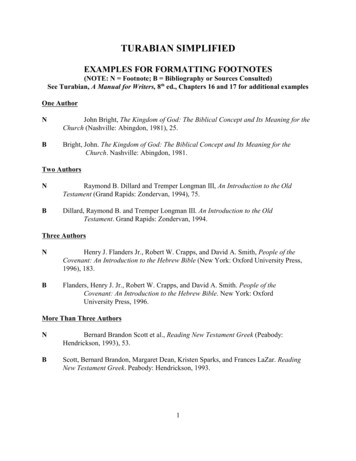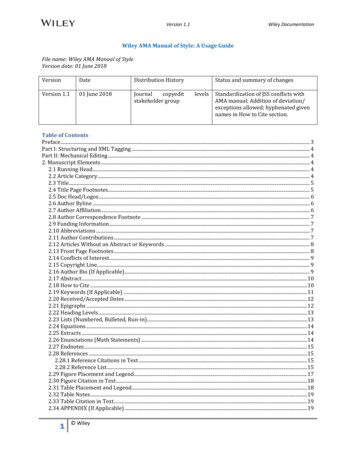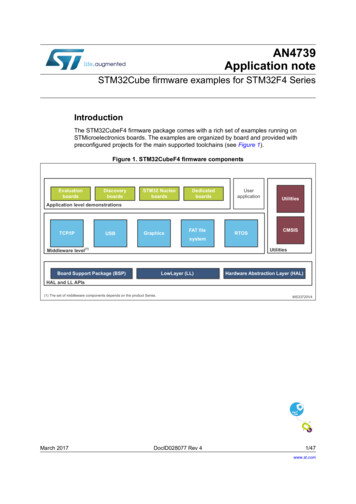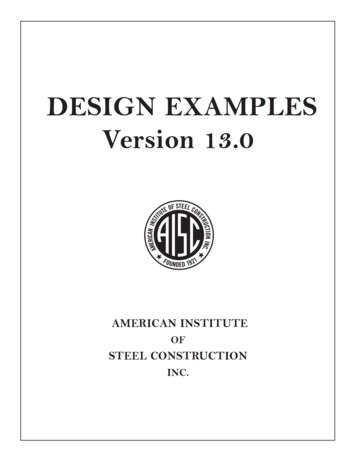
Transcription
TURABIAN SIMPLIFIEDEXAMPLES FOR FORMATTING FOOTNOTES(NOTE: N Footnote; B Bibliography or Sources Consulted)See Turabian, A Manual for Writers, 8th ed., Chapters 16 and 17 for additional examplesOne AuthorNJohn Bright, The Kingdom of God: The Biblical Concept and Its Meaning for theChurch (Nashville: Abingdon, 1981), 25.BBright, John. The Kingdom of God: The Biblical Concept and Its Meaning for theChurch. Nashville: Abingdon, 1981.Two AuthorsNRaymond B. Dillard and Tremper Longman III, An Introduction to the OldTestament (Grand Rapids: Zondervan, 1994), 75.BDillard, Raymond B. and Tremper Longman III. An Introduction to the OldTestament. Grand Rapids: Zondervan, 1994.Three AuthorsNHenry J. Flanders Jr., Robert W. Crapps, and David A. Smith, People of theCovenant: An Introduction to the Hebrew Bible (New York: Oxford University Press,1996), 183.BFlanders, Henry J. Jr., Robert W. Crapps, and David A. Smith. People of theCovenant: An Introduction to the Hebrew Bible. New York: OxfordUniversity Press, 1996.More Than Three AuthorsNBernard Brandon Scott et al., Reading New Testament Greek (Peabody:Hendrickson, 1993), 53.BScott, Bernard Brandon, Margaret Dean, Kristen Sparks, and Frances LaZar. ReadingNew Testament Greek. Peabody: Hendrickson, 1993.1
2Corporate AuthorNSouthern Baptist Convention, Annual of the Southern Baptist Convention(Nashville: Southern Baptist Convention, 1975), 25.BSouthern Baptist Convention. Annual of the Southern Baptist Convention. Nashville:Southern Baptist Convention, 1975.Editor or Translator as AuthorNTimothy E. Fulop and Albert J. Raboteau, eds., African-American Religion:Interpretive Essays in History and Culture (New York: Routledge, 1997), 412-414.BFulop, Timothy E., and Albert J. Raboteau, eds. African-American Religion:Interpretive Essays in History and Culture. New York: Routledge, 1997.Editor or Translator in Addition to An AuthorNTheodor W. Adorno and Walter Benjamin, The Complete Correspondence, 19281940, ed. Henri Lonitz, trans. Nicholas Walker (Cambridge, MA: Harvard UniversityPress, 1999), 212.BAdorno, Theodor W., and Walter Benjamin. The Complete Correspondence, 1928-1940.Edited by Henri Lonitz. Translated by Nicholas Walker. Cambridge, MA:Harvard University Press, 1999.EditionNRoger Daniels, Coming to America: A History of Immigration and Ethnicity inAmerican Life, 2nd ed. (New York: Harper Perennial, 2001), 12.BDaniels, Roger. Coming to America: A History of Immigration and Ethnicity inAmerican Life. 2nd ed. New York: Harper Perennial, 2001.Note: Revised edition is rev.ed. in the footnote and Rev. ed. in the bibliography.ReprintNJohn L. Nevius, Demon Possession (New York: Fleming H. Revell, 1894; reprint,Grand Rapids: Kregel, 1968), 274.BNevius, John L. Demon Possession. New York: Fleming H. Revell, 1894; reprint, GrandRapids: Kregel, 1968.
3Journal Articlesa. If the journal article appears in print, follow this format:NGeoffrey J. Aimers, “The Rhetoric of Social Conscience in the Book of Job,”Journal for the Study of the Old Testament 91 (2000): 75.BAimers, Geoffrey J. “The Rhetoric of Social Conscience in the Book of Job.”Journal for the Study of the Old Testament 91 (2000): 99-107.b. If the journal article is found in an online journal, include the URL and the access date:NLisa J. Kiser, “Silencing the Lambs: Economics, Ethics, and Animal Life inMedieval Franciscan Hagiography,” Modern Philology 108 (2011): 340,http://dx.doi.org/10.1086/658052 (accessed September 18, 2011).BKiser, Lisa J. “Silencing the Lambs: Economics, Ethics, and Animal Life in MedievalFranciscan Hagiography.” Modern Philology 108 (2011): 323-42.http://dx.doi.org/10.1086/658052 (accessed September 18, 2011).Chapter or Article in a BookNTikva Frymer-Kensky, “Law and Philosophy: The Case of Sex in the Bible,” inWomen in the Hebrew Bible, ed. Alice Bach (New York: Routledge, 1999), 295.BFrymer-Kensky, Tikva. “Law and Philosophy: The Case of Sex in the Bible.” InWomen in the Hebrew Bible, edited by Alice Bach, 293-305. New York:Routledge, 1999.Encyclopedia ArticleNClaude F. Mariottini, “Laban,” The Anchor Bible Dictionary, ed. David NoelFreedman (New York: Doubleday, 1992), 4:113.BMariottini, Claude F. “Laban.” The Anchor Bible Dictionary. Vol 4. Edited byDavid Noel Freedman. New York: Doubleday, 1992. 4:113-114.BFreedman, David Noel, ed. Anchor Bible Dictionary. 6 vols. New York: Doubleday,1992.
4Book Review (one author)NClaude Mariottini, review of Reading the Bible with the Damned by Bob Ekblad,The Expository Times 119 (2008): 411-412.BMariottini, Claude. Review of Reading the Bible with the Damned by Bob Ekblad.The Expository Times 119 (2008): 411-412.Book Review (edited work)NCarol Meyers, review of The Archaeology of Israel: Constructing the Past,Interpreting the Present, ed. Asher Silberman and David Small, Journal of BiblicalLiterature 118 (1999): 530-531.BMeyers, Carol. Review of The Archaeology of Israel: Constructing the Past,Interpreting the Present, ed. Asher Silberman and David Small. Journalof Biblical Literature 118 (1999): 530-531.Magazine ArticleNAnna Quindlen, “The Inalienable Right to Whine,” Newsweek, December13,1995, 102.BQuindlen, Anna. “The Inalienable Right to Whine.” Newsweek, December 13, 1995,102-04.NewspaperNManya Brachear Pashman, “Old Cultures, New Synagogue,” Chicago ory (accessed September 5, 2013).BPashman, Manya Brachear. “Old Cultures, New Synagogue.” Chicago ory (accessed September 5, 2013).Internet Material (with author’s name)NThomas A. K. Reilly, “Moses,” d August 5, 2008).BReilly, Thomas A. K. “Moses.” d August 5, 2008).
5Internet Material (without author’s name)NB“Moses,” http://en.wikipedia.org/wiki/Moses (accessed August 5, 2008).“Moses.” http://en.wikipedia.org/wiki/Moses (accessed August 5, 2008).Commentary (single volume in a series)NJohn B. Polhill, Acts, New American Commentary (Nashville: Broadman andHolman, 1992), 175.BPolhill, John B. Acts. New American Commentary. Nashville: Broadman andHolman, 1992.Commentary (multiple volume in a series)NF. Delitzsch, Biblical Commentary on the Book of Job, Biblical Commentary onthe Old Testament (Grand Rapids: Eerdmans, 1949), 2:115.BDelitzsch, F. Biblical Commentary on the Book of Job. Vol 2. Biblical Commentary onthe Old Testament. Grand Rapids: Eerdmans, 1949.Commentary (one of many commentaries in a volume in a series)NTheophile J. Meek, “The Song of Songs,” The Interpreter’s Bible (Nashville:Abingdon, 1956), 5:91.BMeek, Theophile J. “The Song of Songs.” The Interpreter’s Bible. Vol. 5. New York:Abingdon, 1956. 5:91-148.Theses and DissertationsNPhuichun Richard Choi, “Abraham Our Father: Paul’s Voice in the CovenantalDebate of the Second Temple Period” (PhD diss., Fuller Theological Seminary, 1997),189.BChoi, Phuichun Richard. “Abraham Our Father: Paul’s Voice in the Covenantal Debate ofthe Second Temple Period.” PhD diss., Fuller Theological Seminary, 1997.
6NDarryl Saffore, “Equipping Participants at Nehemiah Discipleship House To Leada Structured Life Through Mandatory Group Bible Study at Lawndale CommunityChurch,” (DMin thesis, Northern Baptist Theological Seminary, 2013).BSaffore, Darryl. “Equipping Participants at Nehemiah Discipleship House To Lead aStructured Life Through Mandatory Group Bible Study at Lawndale CommunityChurch.” DMin thesis, Northern Baptist Theological Seminary, 2013.Short TitleNBBright, The Kingdom of God, 75.Bright, John. The Kingdom of God: The Biblical Concept and Its Meaning for theChurch. Nashville: Abingdon, 1981.Same Title, Same Page (Use Ibid)NIbid.Same Title, Different Page (Use Ibid)NIbid., 83.One Author (Author appears more than once)NBJohn Bright, A History of Israel (Philadelphia: The Westminster, 1981), 175. A History of Israel. Philadelphia: The Westminster, 1981.Secondary Quotation (a quote from a book found in another book)NWilliam J. Wildon, Power, Racism and Privilege: Race Relations in Theoreticaland Sociological Perspectives (New York: Free Press, 1973), 34; quoted in Douglas R.Sharp, No Partiality: The Idolatry of Race and the New Humanity (Downers Grove:InterVarsity, 2002), 92.BWildon, William J. Power, Racism and Privilege: Race Relations in Theoreticaland Sociological Perspectives. New York: Free Press, 1973, 34. Quotedin Douglas R. Sharp, No Partiality: The Idolatry of Race and the NewHumanity. Downers Grove: InterVarsity, 2002.
7Electronic SourcesNorthern’s policy on electronic sources is as follows: “Find and cite print sources rather thanonline sources.” Students may not cite an electronic source for a book that is common or readilyavailable in the library.If this is not possible, follow these examples:CD-ROMNGeorge MacDonald, At the Back of the North Wind, In Master Christian Library,version 6 [CD-ROM] (Albany, OR: AGES Software, 1996).BMacDonald, George. At the Back of the North Wind. In Master Christian Library.Version 6. CD-ROM. Albany, OR: AGES Software, 1996.NFrank E. Gaebelein, ed., Expositor’s Bible Commentary: With the NewInternational Version of the Bible in Zondervan NIV Study Bible Library [CD-ROM](Grand Rapids: Zondervan, 2001).BGaebelein, Frank E., ed. Expositor’s Bible Commentary: With the New InternationalVersion of the Bible. In Zondervan NIV Study Bible Library. CD-ROM. GrandRapids: Zondervan, 2001.E-BooksPagination differs in iPad, Nook, Kindle, TouchPad, and e-Readers. When citing an electronicbook (e-Book) the reference must contain the actual type or model of e-Book being used (Kindle,Microsoft, Nook, Sony, TouchPad) and the location number of the quote, since actual pagenumbers are not created. For example:ND. Brent Laytham, ed., God Does Not . . . : Entertain, Play Matchmaker, Hurry,Demand Blood, Cure Every Illness (Grand Rapids: Brazos Press, 2008), Kindle e-book,locations 552–53.BLaytham, D. Brent ed. God Does Not . . . : Entertain, Play Matchmaker, Hurry,Demand Blood, Cure Every Illness. Kindle e-book, locations 552–53.Grand Rapids: Brazos Press, 2008.
8Citing the Biblea. When citing the Bible in the text, cite the name of the books in full. When citing specific textsin parenthesis, use the traditional abbreviation for the books (see Turabian 24.6). Do not useperiods after the title of the books.b. When citing the Bible for the first time, use the following note:NUnless otherwise indicated, all Bible references are from the New RevisedStandard Version (NRSV).The Use of Commas (See Turabian 21.2)a. In a series of three or more words, phrases, or clauses, use a comma before the conjunctionthat introduces the last item:Example:The air was cold, wet, and breezy.b. A comma precedes the coordinating conjunctions and, but, or, nor, for, and the connectives soand yet between main clauses.c. Use a comma after an introductory adverb clause. Introductory adverbs are: after, although, as,as far as, as soon as, because, before, if, lest, no matter how, now that, once provided, since,though, unless, until, when, whenever, where, wherever, while.The Use of Semicolons (See Turabian 21.3)A semicolon is used to designate a greater pause in a sentence. It functions as a softer period. Usea semicolon to separate independent clauses in a compound sentence.Formatting Notesa. Times New Roman 12 should be the font used for both text and footnotes.b. Leave a space between notes.c. When numbering your notes, use arabic numbers.
9Example of Notes1John Bright, The Kingdom of God: The Biblical Concept and Its Meaning for theChurch (Nashville: Abingdon, 1981), 25.2Raymond B. Dillard and Tremper Longman III, An Introduction to the Old Testament(Grand Rapids: Zondervan, 1994), 75.3Henry J. Flanders Jr., Robert W. Crapps, and David A. Smith, People of the Covenant:An Introduction to the Hebrew Bible (New York: Oxford University Press, 1996), 183.4Geoffrey J. Aimers, “The Rhetoric of Social Conscience in the Book of Job,” Journalfor the Study of the Old Testament 91 (2000): 75.5Tikva Frymer-Kensky, “Law and Philosophy: The Case of Sex in the Bible,” in Womenin the Hebrew Bible, ed. Alice Bach (New York: Routledge, 1999), 295.6Claude F. Mariottini, “Laban,” The Anchor Bible Dictionary, ed. David Noel Freedman(New York: Doubleday, 1992), 4:113.7Claude Mariottini, review of Reading the Bible with the Damned by Bob Ekblad, TheExpository Times 119 (2008): 411-412.8Carol Meyers, review of The Archaeology of Israel: Constructing the Past, Interpretingthe Present, ed. Asher Silberman and David Small, Journal of Biblical Literature 118 (1999):530-531.9Anna Quindlen, “The Inalienable Right to Whine,” Newsweek, December 13, 1995, 102.10Thomas A. K. Reilly, “Moses,” d August 5, 2008).11“Moses,” http://en.wikipedia.org/wiki/Moses (accessed August 5, 2008).12John B. Polhill, Acts, New American Commentary (Nashville: Broadman and Holman,1992), 175.13F. Delitzsch, Biblical Commentary on the Book of Job, Biblical Commentary on the OldTestament (Grand Rapids: Eerdmans, 1949), 2:115.
1014Theophile J. Meek, “The Song of Songs,” The Interpreter’s Bible (Nashville:Abingdon, 1956), 5:91.15Bright, The Kingdom of God, 75.16Ibid.17Ibid., 83.18John Bright, A History of Israel (Philadelphia: Westminster, 1981), 175.19William J. Wildon, Power, Racism and Privilege: Race Relations in Theoretical andSociological Perspectives (New York: Free Press, 1973), 34; quoted in Douglas R. Sharp, NoPartiality: The Idolatry of Race and the New Humanity (Downers Grove: InterVarsity, 2002), 92.20George MacDonald, At the Back of the North Wind, In Master Christian Library,version 6 [CD-ROM] (Albany, OR: AGES Software, 1996).21Frank E. Gaebelein, ed., Expositor’s Bible Commentary: With the New InternationalVersion of the Bible in Zondervan NIV Study Bible Library [CD-ROM] (Grand Rapids:Zondervan, 2001).
Example of a BibliographyBIBLIOGRAPHYAimers, Geoffrey J. “The Rhetoric of Social Conscience in the Book of Job.” Journal for theStudy of the Old Testament 91 (2000): 99-107.Bright, John. A History of Israel. Philadelphia: Westminster, 1981. The Kingdom of God: The Biblical Concept and Its Meaning for the Church.Nashville: Abingdon, 1981.Delitzsch, F. Biblical Commentary on the Book of Job. Vol 2. Biblical Commentary on the OldTestament. Grand Rapids: Eerdmans, 1949.Dillard, Raymond B. and Tremper Longman III. An Introduction to the Old Testament. GrandRapids: Zondervan, 1994.Flanders, Henry J. Jr., Robert W. Crapps, and David A. Smith. People of the Covenant: AnIntroduction to the Hebrew Bible. New York: Oxford University Press, 1996.Frymer-Kensky, Tikva. “Law and Philosophy: The Case of Sex in the Bible.” In Women in theHebrew Bible, ed. Alice Bach, 293-305. New York: Routledge, 1999.Gaebelein, Frank E., ed. Expositor’s Bible Commentary: With the New InternationalVersion of the Bible. In Zondervan NIV Study Bible Library. CD-ROM. GrandRapids: Zondervan, 2001.Laytham, D. Brent ed. God Does Not . . . : Entertain, Play Matchmaker, Hurry,Demand Blood, Cure Every Illness. Kindle e-book, locations 552–53.Grand Rapids: Brazos Press, 2008.MacDonald, George. At the Back of the North Wind. In Master Christian Library.Version 6. CD-ROM. Albany, OR: AGES Software, 1996.Mariottini, Claude F. “Laban.” The Anchor Bible Dictionary. Vol 4. Edited by David NoelFreedman. New York: Doubleday, 1992. 4:113-114. Review of Reading the Bible with the Damned by Bob Ekblad. The Expository Times119 (2008): 411-412.11
12Meek, Theophile J. “The Song of Songs.” The Interpreter’s Bible. Vol. 5. New York: Abingdon,1956. 5:91-148.Meyers, Carol. Review of The Archaeology of Israel: Constructing the Past, Interpreting thePresent, ed. Asher Silberman and David Small. Journal of Biblical Literature 118(1999): 530-531.“Moses.” http://en.wikipedia.org/wiki/Moses (accessed August 5, 2008).Polhill, John B. Acts. New American Commentary. Nashville: Broadman and Holman, 1992.Quindlen, Anna. “The Inalienable Right to Whine.” Newsweek, December 13, 1995, 102-04.Reilly, Thomas A. K. “Moses.” http://www.newadvent.org/cathen/10596a.htm (accessed August5, 2008).Wildon, William J. Power, Racism and Privilege: Race Relations in Theoretical andSociological Perspectives. New York: Free Press, 1973, 34. Quoted in Douglas R. Sharp,No Partiality: The Idolatry of Race and the New Humanity. Downers Grove: InterVarsity,2002.
3 Journal Articles a. If the journal article appears in print, follow this format: N Geoffrey J“ he Rhetoric of Social Conscience in the Book of J” Journal for the Study of the Old Testament 91 (2000): 75. B Aimers, Geoffrey J“ Rhetoric of Social Conscience in the B” Journal for the Study of










